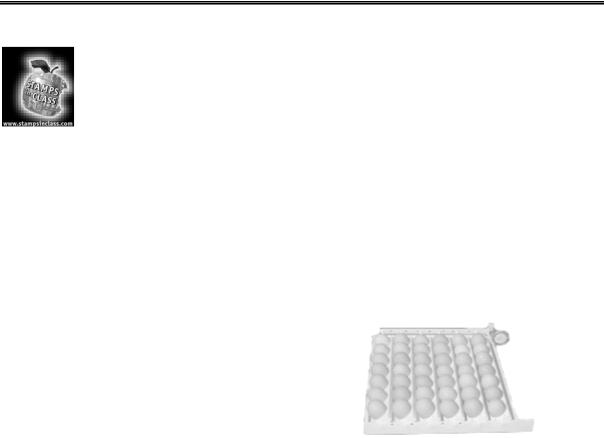
Industrial Control (Students guide, 1999, v1.1 )
.pdf
Appendix G: Parts Listing and Sources
700-00039 |
35 mm Black Film |
|
1 |
|
1 |
1 |
1 |
1 |
1 |
|
Canister |
|
|
|
|
|
|
|
|
700-00040 |
12 VDC Brushless Fan |
|
1 |
1 |
1 |
1 |
1 |
1 |
1 |
800-00027 |
LM34 Temperature |
|
|
|
1 |
1 |
1 |
1 |
1 |
|
Probe |
|
|
|
|
|
|
|
|
800-00028 |
47 Ohm Resistor |
|
|
1 |
1 |
1 |
1 |
1 |
1 |
|
Heater |
|
|
|
|
|
|
|
|
ADC0831 |
ADC 0831 8-bit A/D |
|
|
|
1 |
1 |
1 |
1 |
1 |
|
converter |
|
|
|
|
|
|
|
|
Industrial Control Version 1.1 •Page 259

Appendix H: Commercial Incubator Challenge
Appendix H:
Commercial Incubator
Challenge
Hopefully this text has given you insight into the selection and proper interfacing of industrial field devices.
The film-canister incubator has provided a system for modeling basic process control strategies. The BASIC Stamp is well suited for monitoring and controlling applications ranging from around-the-house hobby
circuits to critical industrial process control. A great project for the serious hobbyist or for a school laboratory is to develop a real microcontroller-based poultry and game bird incubator. Tabletop systems are available for as low as $20.00. GQF Manufacturing of Savanna, Georgia (http://www.gqfmfg.com) is only one of many manufactures that carry a full line of incubators and equipment. The tabletop Model 2362 pictured below would be an excellent choice. It contains a 25 watt 120 VAC heater and a 120 VAC – 500 mA circulating fan. Add to this the Model 1611 egg turner and you have three 120 VAC outputs to control. The total cost is around $90.00.
Mfg #2362N |
Mfg #1611 |
Industrial Control Version 1.1 •Page 261

Appendix H: Commercial Incubator Challenge
Experiment #3 discusses the interfacing of relays to control high voltage, high power loads. The fan and egg turner are turned on and off infrequently and could be controlled with a properly sized electromechanical relay. The heating element will be cycled quickly and should be controlled by an electronic solid-state relay.
Radio shack carries a variety of suitable relays.
An in-line bi-metal mechanical thermostat usually controls the incubator’s heating element. This should be left in place as a “failsafe” cutoff and adjusted to 2 degrees higher than the desired setpoint It would therefore remove power if your electronic thermostat or solid state relay failed. The LM34/ADC 0831 sensor circuit and current boost heater drive circuit used in Experiments #4 through #7 would work great for our real application. Instead of driving the 47-ohm resistor however you would be driving the solid-state relay. The relay, in turn, controls the high-voltage heater.
Optimum hatching temperature is dependant on the type of eggs. For instance, chicken eggs should be incubated at 101.5 while the best temperature for goose and duck eggs is 100.5. The span of the ADC0831 could be more focused around this temperature and Experiment #4 gave you the insight to do this. Doing so would give better resolution and more accurate data.
Your control strategy for the heater could be based on any of the five modes that were discussed in Experiments #5 and #6. Experimentation and plotting with StampPlot Lite gives you the information needed to analyze and evaluate the pros and cons of each method.
An audible alarm for out-of-range conditions would be a good feature to add to the incubator. Radio Shack’s 108 dB Piezo Buzzer (part # 273-057) pictured below would definitely get your attention. And, it could be driven form the BASIC Stamp’s power supply. The current boost BS170 MOSFET used in Figure 3.9d would be an effective drive circuit to deliver its 150 mA requirement.
Over temperature and prolonged under-temperature should be alarmed. You would want to add a couple of pushbutton switch inputs to program for alarm reset and deactivation during initial warm-up. Review Experiment #2 for proper interfacing and programming of digital inputs.
Page 262 •Industrial Control Version 1.1

Appendix H: Commercial Incubator Challenge
A water pan in the incubator ensures that humidity stays high enough to keep the eggs hydrated. How could the BASIC Stamp add intelligence to this aspect of our incubator? Perhaps an LED could flash to remind you to check the water. Or better yet, the moister sensing lab in the Stamps-in-Class Earth Measurements text could be modified to detect the pan being dry. This condition could flash the lamp or beep the alarm. To automate the process, the output of a humidity sensor could be compared to a voltage reference at the inputs to your LM358. The HI/LOW output of the comparator would be an electronic digital input to the Stamp. When humidity drops below the desired value, turn on a humidifier and pipe in some water vapor.
Adding the DS1302 timekeeping chip introduced in Experiment #7 gives you all of the features of a top-of-line commercial incubator. Temperature and humidity is monitored and controlled. Daily reports of temperature variations can be time-stamped and reported. The eggs can be turned at programmed intervals. Cool down can be scheduled and a 1-degree ramp up for the 24 hours before catching can be programmed. Each Experiments 7’s three exercises can be modified to accomplish these tasks. The healthy chicks pictured below are the successful result of maintaining the process for 21 days.
If you dedicate a computer to the system, StampPlot Lite could continually plot and report system conditions. If you really want to get fancy though, StampPlot Pro software adds an enormous amount of computer interface possibilities. Multiple analog channel plotting, full graphic drawing capability, two-way interaction on the fly, and the ability to diplay .jpg and play .wav files only limits the possibilities to the limit of your imagination. In addition, StampPlot Pro’s Internet capability allows you monitor and control the incubator remotely. Stamp Plot Pro is available for evaluation through Parallax at the Stamps in Class web sites.
Industrial Control Version 1.1 •Page 263

Appendix H: Commercial Incubator Challenge
As you can see, this commercial incubator application incorporates the concepts covered in every section of this text. It is doubtful that many of you will be stop here and become chicken ranchers. As you continue to experiment with the BASIC Stamp and apply it to your hobbies and in your real industrial application, keep these concepts in mind and this textbook on your shelf as a reference.
Page 264 •Industrial Control Version 1.1
